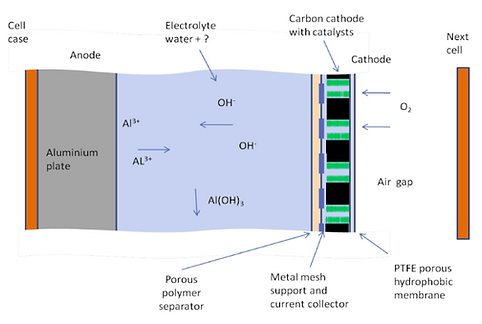Aluminium
+Oxygen
CLEAN POWER
=
Métalectrique's Aluminium-Air Technology
How it works
Aluminium-Air technology has long attracted attention due to its cheap, lightweight and high-energy nature. Aluminium is the most abundant metal on Earth and is easy to handle, store and is safe as a way of storing electrical energy.
A Métalectrique power cell is actually quite simple. A piece of Aluminium is in contact with a special electrolyte. This electrolyte reacts with the metal on the negative end and on the positive end, air reacts with the electrolyte. When those two reactions are combined, aluminium is transformed into hydrated alumina and electrons are transferred from the second layer, through the conductor, ready to power a device. After use, the hydrated alumina can be reprocessed by smelting it, recovering the water and oxygen as it forms fresh aluminium. This cycle can be used over and over again.

The aluminium cycle with Métalectrique technology
These aluminium smelters are green, usually hydro powered. However smelters could also use solar power, wind power, etc. In effect, with this process, energy is transferred, through the aluminium cycle, from green sources of energy into mobile green energy. The whole cycle is green and since the aluminium is recycled, it can be used indefinitely. The 'aluminium-air well' never runs out.

The aluminium cycle with possible byproducts
How a cell is made
A cell in an Aluminium-Air system is built of three layers. The first layer is the aluminium plate, which reacts with the second layer, which is an electrolyte. The third layer is the cathode, allowing air to flow to the second layer. These cells are stacked together to form a battery of the required power output.

Understanding the technology on a small scale can help us understand the technology on a much larger scale. Below are two videos demonstrating the theory in reality. The first one, on the left, is one showcasing 10 cells powering a simple fan. The second video, on the right, is quite unique. Instead of a traditional cell, this version of the technology uses an aluminium can. We call it, the beer can battery!
For understanding the application of this technology on a much bigger scale, scroll down to read further. If you want a deeper look into the technology and the chemistry, then click below for further information.
High Power for
Road, Sea and Sky
These batteries work differently, they are not rechargeable like many other battery technologies. Instead, They are designed to be swapped to give instant ‘refueling’ and since the range is so vast, the swapping is infrequent, hassle free and would require less infrastructure than the current petrol and diesel refueling system we have currently.
The chemistry of this technology was independently verified in France in 2007 and in 2013 the potential range for aluminium air batteries was demonstrated in bench tests. For a standard sized car, a swap would give you 1500 miles before you needed to swap again.
Compare a Métalectrique powered vehicle with a vehicle powered by a lithium-ion battery. When the battery is brand new, a lithium powered car could give you a range of 100 miles with a 6 hour recharge time. Every time the battery recharges, the capacity of power storage goes down and so does the range. Also at 50 pence per mile, you would probably prefer to pay 17 pence per mile and stay with petrol or diesel.
Let’s talk Aluminium-Air. With this technology, you would achieve a range of 1500 miles before having to replace your battery. The swap would take 90 seconds, probably at a local depot near you or by a door to door service. At only 8 pence per mile, you would not only switch from petrol because of your love for the planet, but also because it saves your wallet! Also with a subscription service model, as the technology improves, your mileage goes up. Instead of the capacity going down it goes up.
This high power, long range and scalable technology gives us the capability to not only power cars, but also ships, aircraft and remote places, which is beyond the capability of a rechargeable battery.

